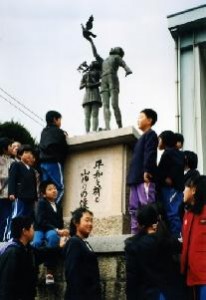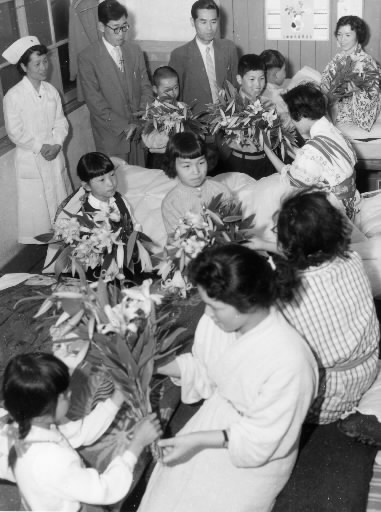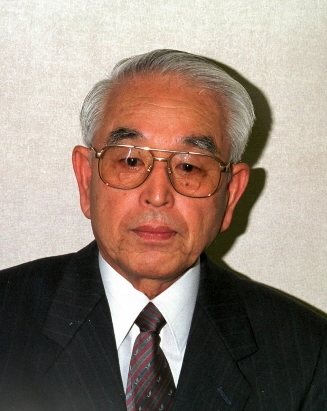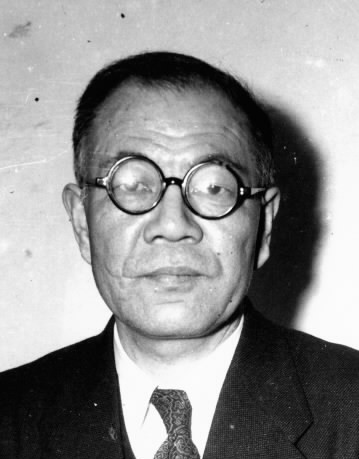History of Hiroshima: 1945-1995 (Part 8, Article 2)
Aug. 1, 2012
Local support to the A-bomb sufferers
by Yoshifumi Fukushima, Staff Writer
Note: This article was originally published in 1995.
The crowd of A-bomb survivors gaze intently at the hands of the person in charge, which hold an Atomic Bomb Survivor’s Certificate. The photo captures the feelings of the survivors toward the small postcard-sized document. Thirty-eight years ago, the Chugoku Shimbun reported that, following the implementation of the Atomic Bomb Medical Relief Law, the certificate was granted to “1,850 survivors in the city of Hiroshima” on the first day it was issued.
For A-bomb survivors, still suffering from the aftereffects of the bomb’s heat rays and radiation, the Atomic Bomb Medical Relief Law was gained only after emotional appeals for legislation that would provide relief measures to the survivors. Though the law did not fill the void concerning “compensation for the dead,” the Atomic Bomb Medical Relief Law and the subsequent A-bomb Survivors Special Measures Law, which together formed the “Two Atomic Bomb-Related Laws,” gradually opened the door to relief measures involving the medical care and welfare of A-bomb survivors. In July of this year, the Atomic Bomb Survivors Relief Law, an integration of the two laws, will take effect.
Filling the gap left by local governments are independent volunteer activities and other support efforts, which include visits to hospitals to bring cheer to hospitalized survivors.
Fifty years after the atomic bombing, there are A-bomb survivors still seeking the Atomic Bomb Survivor’s Certificate, which began being issued under an ardent gaze. Through applications for the certificate filed many years afterward, as well as a look at the background behind activities providing assistance for obtaining the certificate, a glimpse into the hidden lives of A-bomb survivors can be seen.
45 years of hospital visits with mountain lilies
The upper stream of the Ota River flows from the mountains of the Chugoku region into the Hiroshima delta. One elementary school in this mountainous area received a letter on a scroll of heavy Japanese paper. The letter expressed words of thanks written with a brush and ink: “We received the beautiful mountain lilies. We are so grateful for your kindhearted gesture.”
It was the start of summer in the year 1951. The sender of the letter was Fumio Shigeto, the director of the Hiroshima Red Cross Hospital.
“I never dreamed that he would send a letter to us,” recalled Santetsu Imada, a teacher at the school then and now a resident of Nishi Ward, Hiroshima. Mountain lilies were wildflowers that could be gathered easily in the hills behind the school. “While I was surprised by the response of the director, it was the words written by the A-bomb patients that moved me the most.” The suffering of these survivors of the atomic bombing could be glimpsed from the messages that rounded out the letter.
It has been 45 years since Kamitono Elementary School, located in the village of Togouchi in Hiroshima Prefecture, started paying visits to patients in the Atomic Bomb Survivors’ Hospital with mountain lilies in hand. Initially, it began as more of an afterthought. When students from the school were planning to visit an exhibition that was being held in the city of Hiroshima in June of 1951, Mr. Imada and the students thought of bringing flowers to the Red Cross at the same time. The school had been a participant in Red Cross youth activities.
The first flower they thought of were mountain lilies. They pushed aside bamboo grass and gathered them in the hills behind the school. On the day they traveled to Hiroshima, the rental bus was unable to stop at the hospital, so Mr. Imada hurriedly entered the hospital alone and left an armful of mountain lilies with the words: “Please put them on display here. The children from my school gathered them.”
Mountain lilies are also known as bamboo lilies. The name comes from the practice local people have of placing the flowers inside bundles of cut bamboo. The aromatic flowers, small and light pink, are dainty and elegant. “We were glad these everyday flowers could bring so much happiness,” Mr. Imada said.
From the following year, the program of hospital visits began in earnest. It was a time when the people of Hiroshima were preoccupied with the city’s recovery from the bombing, and homes and hospitals had no time or leisure to display flowers in living spaces. In September 1956, the Atomic Bomb Survivors’ Hospital was opened as part of the Hiroshima Red Cross Hospital, and the children started paying visits to the new hospital.
In May 1960, single lilies arrived in the hospital, attached to the front of construction paper covers. “There weren’t as many flowers to pick, so we thought of offering collections of writing instead.” The idea came from a teacher at the time, Takao Takezaki, 62, who now resides in the city of Kure. Mr. Takezaki taught social studies. The students wrote essays about their daily lives and included words of encouragement for the patients. When he was working in the evening, Mr. Takezaki mimeographed the essays. As the roller printed the text, the children turned the paper.
Replies came to the school from the patients, who had come to view the students as their own grandchildren: “Thank you for the lovely-smelling flower”...“I thought of my own home from my hospital bed”...“I will strive to overcome my illness.” The single flower and the inelegant essays held the power to deliver courage to the patients’ hearts.
One year, a male patient suffering from A-bomb-related diseases, who had been sending regular letters of thanks, passed away. The children reread his letters upon receiving news of his death, thinking of the life that had suddenly expired on a white hospital bed. Tears flowed in the classroom as the children were struck by the transience of life. “Although it wasn’t to the same extent as peace education, I think the children learned about the preciousness of life from this experience,” Mr. Takezaki believed.
The shadow of depopulation has begun to fall on the natural habitat of the mountain lilies. A policy of reducing rice acreage that started in the mountainous district in the 1970s has caused the number of mountain lilies to decline substantially. As high economic growth came to metropolitan areas, people moved away from the mountains. Areas where the lilies once grew were replanted with trees and the wild flower, sensitive to changes in the environment, is facing a shrinking habitat.
With depopulation continuing in the mountain villages, an effort to create a statue for the mountain lily was launched. “Along with the dwindling number of mountain lilies, the school’s visits to the hospital were on the verge of ending. The project was at a turning point.” Takahiko Yatate, 41, who was president of the PTA then and serves as an advisor to the Togouchi-cho Tsutsuga Village Commerce and Industry Association, recalled the time.
The flower gathering had turned into a task for the parents, who were forced to search far afield for the lilies. The neighboring village of Geihoku, which designates the mountain lily its official flower, started to balk at these expeditions. In order to bring the project back to the students and the school, a campaign to erect a statue on the school grounds was begun. The presence of the statue would serve as a reminder of the school’s long association with the mountain lily and the A-bomb patients.
A committee was formed composed of people from the school community and local residents. For use in the pedestal of the statue, they were able to obtain the A-bombed stones located in front of the building that housed the town office. In heavy snow, Mr. Yatate and others moved 127 stones to Kamitono Elementary School. As the village was known for its stonework, local craftsmen used their expertise to fashion the pedestal.
The “Statue of the Mountain Lily Praying for Peace” was completed in the summer of 1986 in front of the school auditorium. The statue depicts a boy holding a dove aloft while a girl looks up at the sky, her arms filled with mountain lilies. While some voiced reservations about building the statue, the cost of 1.35 million yen was covered by donations from the local residents and school alumni.
Writing the inscription on the pedestal was entrusted to Mr. Imada. “I practiced writing those words over and over,” he said. He decided to use his right hand, which he had lost use of after suddenly falling unconscious for four days when he first began working at Kamitono Elementary School prior to the war.
Omi Sasaki, who made a speech at the unveiling ceremony for the statue when she was a first-year student at Togouchi Junior High School, is now 21 years old. During the day, she works at a hospital in Tokyo and in the evening she takes college classes to become a registered nurse.
“When it’s the season for mountain lilies,” she said, “I always think of the mountains of Kamitono. When I lived there, and paid visits to the A-bomb Survivors’ Hospital, I came to the decision that I wanted a job where I could help people who are suffering. Since I was little, my dream was to become a nurse. Once I feel confident in my nursing skills, I’d like to return to my hometown.” Her voice was full of hope as she spoke.
Throughout the years, the students and teachers have been bonded by their thoughts and wishes. Principal Katsuyuki Takeda, 56, is convinced of this. “All the teachers have held the common desire that the students recognize the preciousness of life and grow into goodhearted individuals, rather than simply visiting the hospital because they have to.”
The school has viewed the visits to the A-bomb Survivors’ Hospital as a sort of intersection joining days in school, where the students learn about aspects of life, with life itself. In recent years, they have begun mixing in flowers grown at home and at school in order to reduce the number of mountain lilies needed.
“I can’t deny that the pressure I felt due to the many years the visits had been taking place was one factor that made me reluctant to end the activity,” said Koichi Tagata, 56, who was once the principal of the school and still lives in the village. “But if the ‘mountain lily visits’ are what it takes to teach the students respect for life, then they must be continued,” he added with conviction.
As a result, efforts to grow the flowers at the school are continuing. Eleven years ago, the school was lent a patch of land to grow lilies. However, only a handful of flowers grew from the bulbs they planted. Three years ago, Mr. Takeda and other staff members of the school traveled to an agricultural research center in Okayama Prefecture to learn a new growing method which involves planting parts of flower bulbs. Since last spring, they have been experimenting with this new method at the homes of the first-grade children.
In the school room used for cultivation, Mr. Takeda dug his finger in the soil inside a planter. Snow-white bulbs the size of grains of rice were starting to grow. When the flowers will bloom remains uncertain.
At the start of summer in 1964, a letter with these words was sent by a patient in the A-bomb Survivors’ Hospital: “The mountain lilies seem to be watching over us, as if to say, ‘Get well soon.’ Twenty years ago, when I was still a young girl, the atomic bomb was dropped on Hiroshima. The city turned into a picture of hell itself. Even now, people continue to suffer from the effects of the bombing and pass away in this hospital...”
The sender was Marie Nishido. She was a housewife who lived in the village of Fukutomi in Hiroshima Prefecture. Ms. Nishido experienced the atomic bombing while working as a nurse at the Red Cross Hospital. In the wake of the bombing, her gums began to bleed and she was then hospitalized with illness for the next twelve years. She sent the letter at the beginning of her second summer in the hospital. After being discharged, she appealed for support measures for the A-bomb survivors directly to then Prime Minister Eisaku Sato during his visit to Hiroshima. She also took part in a variety of other efforts, such as producing peace calendars. She died abruptly at the age of 65.
“Peace was always on her mind,” said her husband Shigeo, 71, nodding as he looked at a copy of Ms. Nishido’s letter. “She suffered from aplastic anemia. The visits with the mountain lilies were what kept her going during the hard times she spent in the hospital...”
The “Statue of the Mountain Lily Praying for Peace” continues to face southeast from the school grounds of Kamitono Elementary School. About 40 kilometers beyond the mountains is where Hiroshima, and the hypocenter, lie. On the day of the bombing, burnt paper blown far and wide by the blast fell here on the Kamitono District.
“The Hiroshima Yurin Scholarship” ends its mission
The Hiroshima Yurin Scholarship, begun 38 years ago, is set to end its mission of goodwill. The late Michihiko Hachiya, former director of the Hiroshima Communications Hospital and author of “Hiroshima Diary,” which depicts the horror of the atomic bomb, created this scholarship with the royalties from his book. Over the years it has supported the education of A-bomb orphans, but with the passing of time, the need for this financial assistance has declined.
The scholarship program started with a fund of 3.62 million yen. In the beginning, A-bomb orphans in high school were given 2,000 yen per month to help pay for school expenses, but the scholarship has expanded its distribution since that time and now offers roughly 6,000 to 8,000 yen to any high school student experiencing financial difficulties. However, with Japanese society growing wealthier, and new scholarship programs being put in place, there have been no applicants for the Hiroshima Yurin Scholarship for the past five years.
Dr. Hachiya was a physician who labored to treat the victims of the atomic bombing despite suffering severe injuries himself. “Hiroshima Diary,” which consists of his memories of the agonizing conditions he faced in treating the wounded, was the first book about the bombing to be translated into English. It was published in 1955 by North Carolina University, a U.S. institution. However, he decided to donate the royalties of 10,000 dollars, declaring that the money “shouldn’t be used for myself.” Two years later, the scholarship program was born.
The exact number of people who benefited from this scholarship is unknown, but it is estimated that about 300 individuals were given financial assistance. The fund currently totals roughly 18 million yen, which includes additional royalties from Dr. Hachiya’s book, but the sum remains insufficient to increase the scholarship amounts. The Hiroshima City Council of Social Welfare, where the headquarters of the fund is located, is preparing to end the scholarship program by transferring the funds to another social welfare foundation.
Dr. Hachiya passed away in April 1980 at the age of 76. These days, few people are aware of the background behind the scholarship he created. His eldest son, Shuuichi, who watches over the final wishes of his father in his role with the fund, said, “It’s a bit sad, but even if the nature of the foundation changes, if the money can continue to help the people of Hiroshima, I’ll be pleased.”
(Originally published on March 12, 1995)











